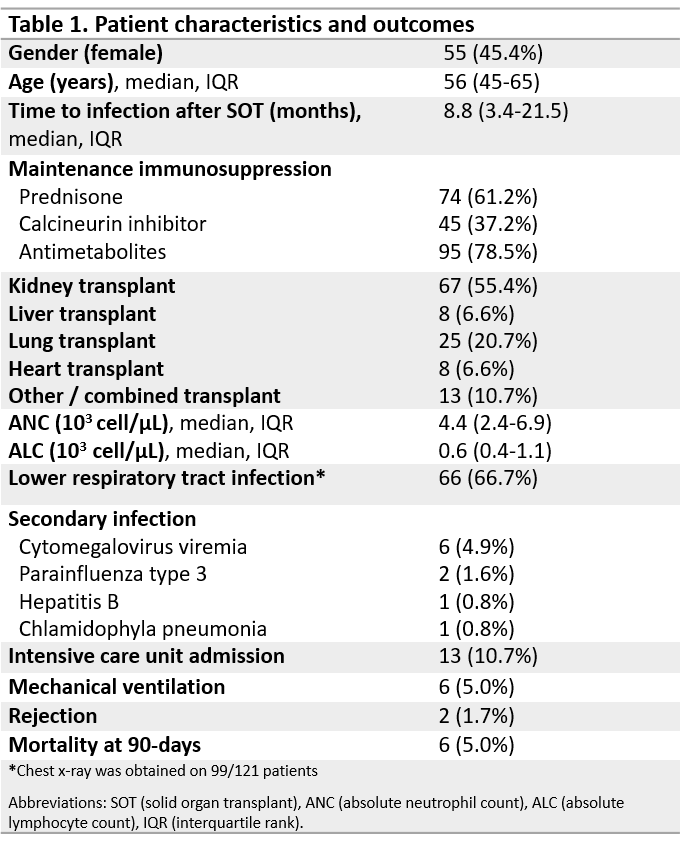Rhinovirus Infection in Solid Organ Transplant Recipients
G. Motoa1, M. A. Mendoza1, M. Raja1, J. Simkins2, S. Anjan2, E. Martin2, A. Phancao2, N. Sinha2, L. Abbo1, G. Guerra2, Y. Natori2
1Jackson Memorial Hospital / University of Miami, Miami, FL, 2Miami Transplant Institute – University of Miami, Miami, FL
Meeting: 2022 American Transplant Congress
Abstract number: 1645
Keywords: Infection, Outcome, Pneumonia, Rejection
Topic: Clinical Science » Infection Disease » 24 - All Infections (Excluding Kidney & Viral Hepatitis)
Session Information
Session Name: All Infections (Excluding Kidney & Viral Hepatitis) IV
Session Type: Poster Abstract
Date: Tuesday, June 7, 2022
Session Time: 7:00pm-8:00pm
 Presentation Time: 7:00pm-8:00pm
Presentation Time: 7:00pm-8:00pm
Location: Hynes Halls C & D
*Purpose: Respiratory viral infections are one of the most common infections in solid organ transplant recipients (SOTR), causing significant morbidity and mortality. Limited data is available for rhinovirus infection in SOTR. We aimed to describe the clinical characteristics and outcomes of SOTR with this infection.
*Methods: This was a retrospective cohort study between 01/01/2017 and 12/31/2020. We included adult SOTR with an active graft with either nasopharyngeal swab or bronchoalveolar lavage specimens positive for Rhinovirus via Filmarray® 2.0 and Torch, BioMérieux. Multiple regression model was developed based on univariate analysis result to identify the risk factors for lower respiratory tract infection (LRTI).
*Results: We identified 121 patients including 67 kidney, 8 liver, 25 lung, 8 heart, and 13 combined transplant recipients (Table 1). Hospital and intensive care unit admission rate was 75.2% (91/121) and 10.7% (13/121), respectively. Chest x-ray was obtained in 99 patients, and LRTI was present in 66 patients (66.7%). In multivariate model, male gender was shown to be associated with development of LRTI (p=0.026, odds ratio 2.70, 95% confidence interval (1.12 -6.67). Patients with low absolute lymphocyte count (ALC) had a trend to develop LRTI (p=0.08, odds ratio 1.80, 95% confidence interval 0.93-3.47). Secondary infection, within 3 months of diagnosis, was observed in 10 patients (8.3%) with 6 cytomegalovirus viremia, 2 parainfluenza, 1 hepatitis B, and 1 Chlamidophyla pneumonia. Only 6 patients (5.0%) died, and 2 patients (1.7%) had biopsy-proven graft rejection within 3 months after diagnosis.
*Conclusions: This study revealed that male gender increases the risk of developing LRTI. There was a trend that low ALC was associated with LRTI. Within 3 months after diagnosis, overall mortality was 5%. Further studies are necessary to identify risk factors to develop rhinovirus infection.
To cite this abstract in AMA style:
Motoa G, Mendoza MA, Raja M, Simkins J, Anjan S, Martin E, Phancao A, Sinha N, Abbo L, Guerra G, Natori Y. Rhinovirus Infection in Solid Organ Transplant Recipients [abstract]. Am J Transplant. 2022; 22 (suppl 3). https://atcmeetingabstracts.com/abstract/rhinovirus-infection-in-solid-organ-transplant-recipients/. Accessed December 3, 2025.« Back to 2022 American Transplant Congress

